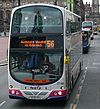
George Square is the principal civic square in the city of Glasgow, Scotland. It is one of six squares in the city centre, the others being Cathedral Square, St Andrew's Square, St Enoch Square, Royal Exchange Square, and Blythswood Square on Blythswood Hill.

Buchanan Street is one of the main shopping thoroughfares in Glasgow, the largest city in Scotland. It forms the central stretch of Glasgow's famous shopping district with a generally more upmarket range of shops than the neighbouring streets: Argyle Street, and Sauchiehall Street.

The Merchant City, a new name introduced through urban renewal by the Scottish Development Agency and the city council in the 1980s is one part of the metropolitan central area of Glasgow. It commences at George Square and goes eastwards reaching Glasgow Cross, in the centre of Glasgow, Scotland. The eastern fringe of the Merchant City contains part of Glasgow's original medieval street plan, which stretches northwards towards neighbouring Townhead.
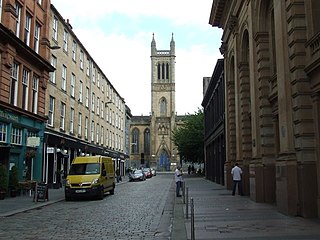
Candleriggs is a street in the city of Glasgow, Scotland. It is located in the Merchant City area of the city centre.

Catherine Cranston, widely known as Kate Cranston or Miss Cranston, was a leading figure in the development of tea rooms. She is nowadays chiefly remembered as a major patron of Charles Rennie Mackintosh and Margaret MacDonald, in Glasgow, Scotland. The name of Miss Cranston's Tea Rooms lives on in reminiscences of Glasgow in its heyday.
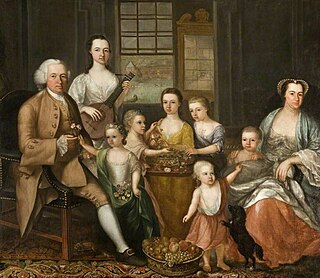
The Tobacco Lords were a group of Scottish merchants active during the Georgian era who made substantial sums of money via their participation in the triangular trade, primarily through dealing in slave-produced tobacco that was grown in the Thirteen Colonies. Concentrated in the port city of Glasgow, these merchants utilised their fortunes, which were also partly made via the direct ownership of slaves, to construct numerous townhouses, churches and other buildings in Scotland.

The Royal Exchange Square is a public square in Glasgow, Scotland. The square lies between Buchanan Street and Queen Street, opening out Queen Street and Ingram Street to the south of George Square. It is also easily accessible from Buchanan Street on the west side of the square, through two prominent archways at Royal Bank Place. The square is a landmark due to its distinguished architecture which attracts many visitors. It is one of six squares in the city centre.

John Glassford was a Scottish merchant and planter. One of the most prominent Tobacco Lords of Scotland, Glassford owned tobacco-producing slave plantations in the British North American colonies of Virginia and Maryland, for which he has become controversial in the 21st century.
Events from the year 1700 in the Kingdom of Scotland.

The Corinthian Club is a private members club in Ingram Street, Glasgow, Scotland. It is accommodated in former bank building which, as Lanarkshire House, became the headquarters of Lanarkshire County Council. It is a Category A listed building.

Queen Street is one of the major thoroughfares in the city of Glasgow, Scotland. The street runs north from Argyle Street until it reaches George Square at the junction with St. Vincent Street. Several local landmarks are located on this street including Royal Exchange Square, with the Gallery of Modern Art at the junction with Ingram Street.
William Cunninghame of Lainshaw (1731–1799) was a Scottish merchant and leading Tobacco Lord who headed one of the major Glasgow syndicates that came to dominate the transatlantic tobacco trade. Most of the tobacco shipped from North American slave plantations was sold to France. He later also made a further fortune stockpiling tobacco bought at keen prices shortly before the American Revolution, assuming that Great Britain would not be able to retain control over her rebellious colonies, and then selling at high prices. Cunninghame's neo-classical house on Glasgow's Queen Street today houses the collection of the Gallery of Modern Art.

Andrew Buchanan of Drumpellier was a Scottish tobacco merchant who was one of Glasgow's "Tobacco Lords". He served as Lord Provost of Glasgow from 1740 to 1742. Buchanan Street in Glasgow is named after him.
Archibald Ingram (1699–1770) was an 18th-century tobacco lord who served as Lord Provost of Glasgow from 1762 to 1764. Ingram Street in the city centre was named in his honour in 1781.
Lawrence Dinwiddie of Germiston (1696–1764) was an 18th-century Scottish tobacco lord who served as Lord Provost of Glasgow from 1742 to 1744.
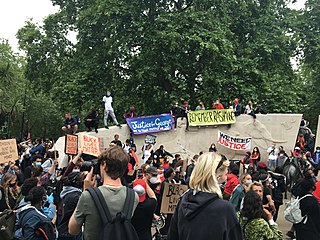
Protests were held across the United Kingdom following the murder of George Floyd, a 46-year-old African-American man, by a police officer in the United States on 25 May 2020. Immediately following his murder, protests and riots occurred in dozens of cities across the United States. Protests were staged internationally for the first time on 28 May, with a solidarity demonstration outside the United States Embassy in London. They took place during the UK COVID-19 pandemic.

A number of statues and memorials were the subject of protests and petitions during the George Floyd protests in the United Kingdom in 2020.
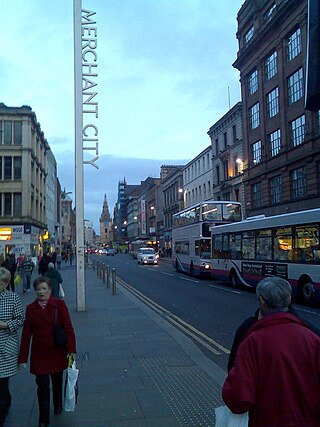
Glassford Street is a major thoroughfare in the city of Glasgow, the largest city in Scotland. The street runs north from the junction of Argyle Street and Trongate through the Merchant City until it meets Ingram Street.
Cochrane Street is a major thoroughfare in the city of Glasgow, the largest city in Scotland. The street runs east from the junction of George Square and South Frederick Street through the Merchant City until it meets Montrose Street.
Dunlop Street is a thoroughfare in the city of Glasgow, the largest city in Scotland. The street runs east from Maxwell Street running east parallel to Clyde Street before making a right turn to join Clyde Street.














